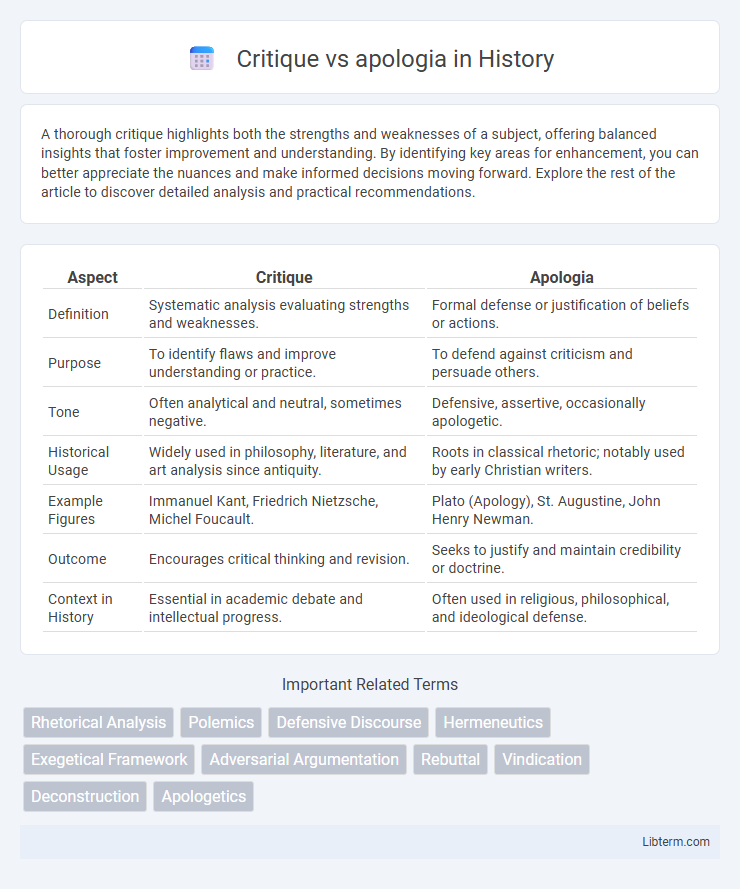A thorough critique highlights both the strengths and weaknesses of a subject, offering balanced insights that foster improvement and understanding. By identifying key areas for enhancement, you can better appreciate the nuances and make informed decisions moving forward. Explore the rest of the article to discover detailed analysis and practical recommendations.
Table of Comparison
| Aspect | Critique | Apologia |
|---|---|---|
| Definition | Systematic analysis evaluating strengths and weaknesses. | Formal defense or justification of beliefs or actions. |
| Purpose | To identify flaws and improve understanding or practice. | To defend against criticism and persuade others. |
| Tone | Often analytical and neutral, sometimes negative. | Defensive, assertive, occasionally apologetic. |
| Historical Usage | Widely used in philosophy, literature, and art analysis since antiquity. | Roots in classical rhetoric; notably used by early Christian writers. |
| Example Figures | Immanuel Kant, Friedrich Nietzsche, Michel Foucault. | Plato (Apology), St. Augustine, John Henry Newman. |
| Outcome | Encourages critical thinking and revision. | Seeks to justify and maintain credibility or doctrine. |
| Context in History | Essential in academic debate and intellectual progress. | Often used in religious, philosophical, and ideological defense. |
Understanding Critique and Apologia
Critique involves a detailed analysis and evaluation of ideas, actions, or works to identify strengths and weaknesses, promoting intellectual growth and improvement. Apologia is a reasoned defense or justification of a position, behavior, or belief, aiming to explain and uphold it against criticism. Understanding critique requires openness to feedback and reflection, while apologia emphasizes clarity in presenting arguments and addressing objections.
Historical Roots of Critique and Apologia
Critique originated in ancient Greek philosophy, particularly through Socratic questioning, aimed at uncovering truth by rigorously examining beliefs and ideas. Apologia, rooted in classical rhetoric, serves as a formal defense or justification, exemplified by figures like Plato's "Apology," where Socrates defends his life and philosophy against accusations. The historical roots of critique emphasize questioning and analytical evaluation, while apologia centers on persuasion and vindication within social or legal contexts.
Key Differences Between Critique and Apologia
Critique involves an objective analysis and evaluation of ideas, works, or arguments, emphasizing strengths and weaknesses for constructive feedback. Apologia serves as a formal defense or justification, often responding to criticism by explaining and defending a particular position or action. The key difference lies in critique being evaluative and neutral, while apologia is inherently persuasive and protective.
Purposes and Functions in Discourse
Critique serves to analyze, evaluate, and often challenge ideas or works, fostering deeper understanding and encouraging improvement within discourse. Apologia functions primarily as a defensive response, aiming to justify, explain, or defend an individual's actions or position to preserve credibility. Both play pivotal roles in shaping argumentation dynamics, with critique promoting critical reflection and apologia reinforcing self-presentation.
Methods and Approaches to Critique
Methods and approaches to critique emphasize analytical evaluation, employing techniques like comparative analysis, textual examination, and contextual interpretation to unravel underlying meanings and biases. Critics prioritize evidence-based reasoning and engage with multiple perspectives to challenge assumptions and deepen understanding of a subject. This systematic inquiry contrasts with apologia, which tends to focus on defense and justification rather than objective scrutiny.
Strategies Used in Apologia
Apologia employs strategies such as denial, bolstering, differentiation, transcendence, and corrective actions to defend reputation and restore credibility after a crisis. These methods focus on minimizing responsibility, emphasizing positive qualities, reframing the issue, and promising improvements to regain trust. Effective use of apologia strategies enhances organizational or individual image by addressing accusations with logical explanations and emotional appeals.
Impact on Public Perception and Dialogue
Critique shapes public perception by highlighting flaws and prompting critical examination, often fostering a more informed and skeptical audience. Apologia, in contrast, seeks to defend and justify actions or beliefs, which can mitigate negative opinions and preserve reputations but may limit open dialogue. Both influence discourse dynamics, as critique encourages accountability while apologia often aims to maintain trust and legitimacy.
Common Misconceptions and Overlaps
Critique and apologia often overlap as both involve defense or evaluation, but critique aims for objective analysis while apologia focuses on justification or defense of specific actions or beliefs. Common misconceptions include viewing critique solely as negative judgment and apologia as mere excuses, when critique can be constructive and apologia can provide reasoned explanation. Understanding their distinct purposes clarifies their application in academic, literary, and personal contexts.
Critique and Apologia in Contemporary Issues
Critique in contemporary issues functions as an analytical tool that deconstructs prevailing narratives, exposing underlying power dynamics and biases to foster deeper understanding and social change. Apologia serves as a strategic response, aiming to defend or justify controversial actions or beliefs by reconstructing reputation and mitigating criticism. Together, they shape discourse by balancing scrutiny with defense, influencing public perception and policy formation.
Choosing Between Critique and Apologia
Choosing between critique and apologia depends on the communicative goal and context; critique involves objective analysis and evaluation of ideas, often highlighting flaws or areas for improvement, while apologia is a defensive response aimed at justifying actions or beliefs to protect reputation. In academic or professional settings, critique fosters growth and intellectual rigor by encouraging constructive feedback, whereas apologia may be more appropriate in scenarios requiring reputation management or conflict resolution. Understanding the audience's expectations and the purpose of the message is crucial for selecting the appropriate approach between critique and apologia.
Critique Infographic

 libterm.com
libterm.com